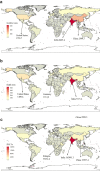Trends in disease burden of chronic myeloid leukemia at the global, regional, and national levels: a population-based epidemiologic study
- PMID: 33292593
- PMCID: PMC7607878
- DOI: 10.1186/s40164-020-00185-z
Trends in disease burden of chronic myeloid leukemia at the global, regional, and national levels: a population-based epidemiologic study
Abstract
Background: Outcomes of chronic myeloid leukemia (CML) has been improved dramatically in the past two decades, but survival levels of CML patients varied in regions. Comprehensive epidemiological research is necessary to evaluate the global burden of CML.
Methods: All data used in our study came from the Global Burden of Disease (GBD) study 2017. Incidence cases, death cases, disability-adjusted life-years (DALYs), and its corresponding age-standardized rate between 1990 to 2017 were used to describe the distribution of CML burden, according to age, sex, social-demographic index (SDI), and countries. Data about attributable risk factors contributing to CML deaths and DALYs were also extracted and analyzed.
Results: Globally, the disease burden of CML gradually decreased from 1990 to 2017. Higher SDI countries achieved a remarkable effect on diminishing the CML burden. Conversely, due to population growth, the incidence cases, death cases, and DALYs of CML in lower SDI quintiles showed an upward trend. India had the most incidence cases and death cases of CML in the world. Additionally, smoking was the most significant attributable risk factor contributing to CML deaths and DALYs, followed by high body mass index.
Conclusion: The disease burden of CML decreased globally, especially in higher SDI countries in the past 28 years. The increasing incidence cases and death cases were mainly observed in lower SDI countries. Additionally, strategies to control modifiable risk factors such as smoking and high body mass index might be useful in diminishing mortality and DALYs.
Keywords: Cancer epidemiology; Chronic myeloid leukemia; Deaths; Global burden; Incidence.
Conflict of interest statement
The authors declare that they have no competing interests.
Figures






References
-
- Hehlmann R, Hochhaus A, Baccarani M. Chronic myeloid leukaemia. The Lancet. 2007;370:342–350. - PubMed
-
- Mendizabal AM, Younes N, Levine PH. Geographic and income variations in age at diagnosis and incidence of chronic myeloid leukemia. Int J Hematol. 2016;103:70–78. - PubMed
-
- Barnes DJ, Melo JV. Cytogenetic and molecular genetic aspects of chronic myeloid leukaemia. Acta Haematol. 2002;108:180–202. - PubMed
-
- Stone RM. Optimizing treatment of chronic myeloid leukemia: a rational approach. Oncologist. 2004;9:259–270. - PubMed
Grants and funding
LinkOut - more resources
Full Text Sources
Miscellaneous

